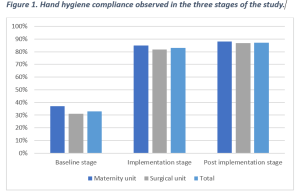Implementation of alcohol-based handrub at the point of care helps to improve hand hygiene compliance in a hospital in Cameroon.


By Dr Lucyna Gozdzielewska and Nkwan Jacob Gobte
Hand hygiene is one of the most important Infection Prevention and Control measures for preventing healthcare-associated infections, yet, hand hygiene compliance remains low in many healthcare settings. To address this, the World Health Organization recommends the multimodal Hand Hygiene Improvement Strategy, consisting of the (1) availability of alcohol-based hand rub at the point of care, (2) provision of hand hygiene training, (3) hand hygiene monitoring and provision of feedback, (4) hand hygiene reminders, and (5) creating a safe institutional climate. However, implementation of hand hygiene guidelines and improving hand hygiene compliance remains challenging, especially in resource-limited settings because of insufficient training, and lack of hand hygiene resources and facilities.
In 2020-2021, we worked with colleagues from Infection Control Africa Network (ICAN) and a researcher from Banso Baptist Hospital (BBH) in Kumbo, Cameroon, to build capacity for hand hygiene compliance in the surgical and maternity units in BBH. The study aimed to evaluate the implementation of alcohol-based handrub at the point of care intervention, supported by provision of hand hygiene training, monitoring of hand hygiene compliance and feedback provision, and appointment of hand hygiene champions.
The design of the study was explained by Jacob, the researcher who coordinated the study in BBH in the SHIP blog in January 2021. In his blog, Jacob also shared his personal experience from this project and lessons learnt. Following up on this, we would like to share the findings from this study, which were published recently in the American Journal of Infection Control and reflect on what has changed in BBH since the project has ended.
The results of our study showed that hand hygiene compliance significantly improved after the implementation of the intervention. At baseline, hand hygiene was performed in 33.3% of observed hand hygiene opportunities, defined by the World Health Organization’s 5 Moments for Hand Hygiene guidelines. During the intervention implementation, hand hygiene compliance increased to 83.1%, and we observed a further increase to 87.2% during the 12-week period after the intervention implementation (Figure 1).
Over the three stages of the study, we also collected data on alcohol-based handrub consumption to ensure the hospital will be able to meet the increased demand for alcohol-based handrub provision in the longer-terms. The study showed that the weekly ABHR usage increased significantly, from 1242.5 millilitres at baseline to 5,670 and 7,740 millilitres during the implementation and post implementation stage, respectively. During the post-implementation stage empty alcohol-based handrub dispensers were refilled with the alcohol-based handrub locally manufactured by the hospital pharmacy; and the increased demand for alcohol-based handrub was successfully met.
The findings of our study demonstrate that hand hygiene interventions can be successfully adapted to local settings and result in a significant improvement in hand hygiene compliance, despite limited resources. Release of the article is a good opportunity to reflect on the project and what has changed since completion of the study. Below, we present a short interview with Jacob on what has changed in BBH since the completion of the project.
Jacob, it has been 22 months since completion of the data collection. How does the hand hygiene practice look like now in the two participating unit?
We continue with the provision of alcohol-based hand rub at the point of care, and the wall-mounted ABHR dispensers are being refilled using the alcohol-based hand rub produced by the hospital pharmacy, and we continue meeting these demands. The project also helped to make changes to organisational culture and staff now pay more attention to ensuring correct hand hygiene practices.
Did the success of the project have an influence on hand hygiene practices in other units of BBH?
Yes, it helped to create awareness about the importance of correct hand hygiene hospital-wide. Furthermore, after the project ended, the provision of alcohol-based hand rub at the point of care was extended to the Covid-19 observation unit.
Did you face any challenges in maintaining good hand hygiene practices over the last 22 months?
The biggest challenge that we experienced was staff turnover. Since the completion of the project, many of the trained observers were transferred to other units or facilities or decided to undertake further education. Although these trained observes can now use their knowledge and experiences to help improve hand hygiene practices in other facilities, it made it harder to sustain these good practices in the two units that participated in the study.
How did the involvement in this project help you personally and professionally?
The project helped me to gain knowledge, skills, and research experience that I can now use in other areas and projects. For example, I recently conducted a pilot project for the development and engagement of family caregivers in infection prevention and control in BBH, and I presented the findings from this work at the Infection Prevention Society conference in Liverpool in October 2023. I also plan to develop this work further, and to complete my PhD study.
What are your plans for further research work?
I am really interested in the role and involvement of family caregivers in preventing infections and have some ideas for further work on this topic. I am planning to conduct a study investigating knowledge, attitudes, and barriers to hand hygiene practice among family caregivers in local hospitals in Cameroon, and a study aiming to build capacity for caregivers’ hand hygiene compliance.
I hope this could then be followed by a rollout of the family caregiver IPC engagement intervention in selected hospitals in Cameroon and an evaluation of the intervention’s effects on patient satisfaction.
Our paper was published in the American Journal of Infection Control and is available in full text to all: https://authors.elsevier.com/sd/article/S0196-6553(23)00629-6
To find out more about the SHIP team, head on to the GCU website, read the rest of our blogs and follow us on Twitter @SHIPGCU
